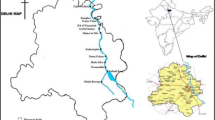Abstract
The rapid population growth and uncontrolled development in the coastal zone have led to major pollution impacts on creeks, estuarine, and coastal environment. Water quality models are valuable tools to understand the environmental processes for prediction of pollution impacts and evaluate future trends for management. Presently, the Malad creek in west coast of Mumbai receives wastewater and sewage from open drains and partially treated sewage from Malad and Versova treatment plants. The objective of the paper is to assess the environmental quality and estimate the extent of improvement in different parts of the creek by enhancing the collection efficiency and adequate treatment of sewage as well as disposal through ocean outfall. A hydrodynamic and water quality simulation has been carried out for the present condition in the creek and calibrated and validated with two different season data for better representation of the system. Calibrated model has been used to generate future scenarios based on various options. Among scenarios, option of treated effluent diverted to propose outfall and improvement in collection of unorganized flow through sewerage up to 40% and 60% are found most significant for biochemical oxygen demand reduction and increase in dissolved oxygen. Fecal coliform reduction is also found drastically but still very high against standard. To improve the environmental quality of the creek, still upper stretch requires more dilution and flushing due to narrow width and contribution of heavy pollution from open drains.
Similar content being viewed by others
References
Clark, R. B. (1992). Marine pollution (3rd ed.). Oxford: Clarendon.
CPCB (1993). Criteria for classification and zoning of coastal waters (sea waters SW)—A coastal pollution control series: COPOCS/6/1993-CPCB, New Delhi, June, 1993.
DHI (2004a). MIKE 21 HD, flow model, hydrodynamic module, user guide. Denmark: Danish Hydraulic Institute (DHI), Water & Environment.
DHI (2004b). MIKE 21 Ecolab, ecological modeling, user guide. Denmark: Danish Hydraulic Institute (DHI), Water & Environment.
GESAMP (1990). State of the marine environment, report and studies, No. 39 (p. 111). Nairobi: UNEP.
Jakobsen, F., Hartstein, N., Frachisse, J., & Golingi, T. (2007). Sabah shoreline management plan: Ecosystem and pollution. Ocean & Coastal Management Borneo, Malaysia, 50(1–2), 84–102. doi:10.1016/j.ocecoaman.2006.03.013.
Karou, J. (1992). The control of land-based sources of marine pollution: Recent international initiatives and prospects. Marine Pollution Bulletin, 25–28, 80–81.
Korfmacher, K. S. (1998). Water quality modeling for environmental management: Lessons from the policy science. Policy Sciences, 31, 35–54. doi:10.1023/A:1004334600179.
Kuo, A. Y., Park, K., Kim, S.-C., & Lin, J. (2005). A tidal prism water quality model for small coastal basins. Coastal Management, 33, 101–117. doi:10.1080/08920750590883015.
Michael, J., & Kennish, T. (1998). Pollution impacts on marine biotic communitites. Boca Raton, FL: CRC.
Mukherji, D. (2002). Degradation of creeks and mangroves and its impact on urban environment: A case study of Mumbai. In Proceedings of the national seminar on creeks, estuaries and mangroves: Pollution and conservation (pp. 331–333).
NEERI (1994). Final report, Bombay sewage disposal project, aerated lagoons, Malad and Versova. Nagpur: National Environmental Engineering Research Institute.
NEERI (2008). Rapid environmental assessment of MSDP Stage II, priority works, pumping stations and pumping mains. Nagpur: National Environmental Engineering Research Institute.
Palanisamy, S., Neelamani, S., Yu-Hwan, A., Ligy, P., & Gi-Hoon, H. (2007). Assessment of the levels of coastal marine pollution of Chennai City, Southern India. Water Resources Management, 21, 1187–1206. doi:10.1007/s11269-006-9075-6.
Park, K., & Kuo, A. Y. (1996). A multi-step computation scheme decoupling kinetic processes from physical transport in water quality models. Water Research, 30, 2255–2264. doi:10.1016/0043-1354(96)00106-6.
Pereira, G. C., Evsukoff, A. G., & Coutinho Ebecken, R. (2004). Coastal environmental management by fuzzy system modeling N.F.F. fuzzy systems. In Proceedings, IEEE international conference (Vol. 1, issue 25–29, pp. 215–220).
Quadros, G. (2002). Proceedings of the national seminar on creeks, estuaries and mangroves, pollution and conservation. Organized by the Zoology Department, Vidya Prasarak Mandals, B. N. Bandodkar College of Science, Thane Maharashtra.
Quadros, G., Vidya, M., Vidya, U., Ghokhale, K. S., & Athalye, R. P. (2001). Status of water quality of Thane Creek, India. ecology. Environmental Conservation, 7(3), 17–22.
Ramesh, R., & Ramachandran, S. (2003). Coastal urban environment. New Delhi: Capital Publishing.
Reckhow, K. H., & Chapra, S. C. (1983). Engineering approaches for lake management: Data analysis and empirical modeling (Vol. 1). Boston, MA: Butterworth.
Samant, H. P. (2002). Quantifying mangrove cover change in and around Mumbai using satellite data. In Proceedings of the national seminar on creeks, estuaries and mangoves: Pollution and conservation (pp. 334–337).
Subramanian, B. R. (1999). Status of marine pollution of India. In Proceeding of Indo-British integrated coastal zone management training short-course conducted by Institute for Ocean Management, Anna University.
Thomann, R., & Mueller, V. J. A. (1987). Principles of surface water quality modeling and control. New York, NY: Harper and Row.
Williams, C. (1996). Combatting marine pollution from land-based activities: Australian initiatives. Ocean and Coastal Management, 33, 87–112. doi:10.1016/S0964-5691(96)00046-4.
Author information
Authors and Affiliations
Corresponding author
Rights and permissions
About this article
Cite this article
Vijay, R., Sardar, V.K., Dhage, S.S. et al. Hydrodynamic assessment of sewage impact on water quality of Malad Creek, Mumbai, India. Environ Monit Assess 165, 559–571 (2010). https://doi.org/10.1007/s10661-009-0967-9
Received:
Accepted:
Published:
Issue Date:
DOI: https://doi.org/10.1007/s10661-009-0967-9




